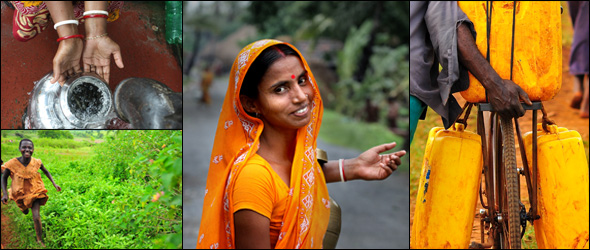Ned Breslin: Scratching the Surface — Retooling the WASH Model’s Indicators (Part III)
Sharing failures can be just as valuable as sharing successes. Yet, the development sector more often touts its successes as indicators to donors, who, in turn, are content to think short term and tend to not ask the tough questions.

’Tis the season for giving. During the holiday season, hundreds of millions of dollars are donated worlwide to non-profit organizations working in the development sector. “Give the gift of clean water” is a common slogan that you are sure to find in your inbox at least a dozen times over the course of the next month.
But what does it mean to give clean water? How do we know that change is occurring? What looks different now, as compared to five years ago? If we had known then what we know now, what would we have done differently from the beginning? Looking five years down the road, will water still be flowing?
Though there is value to sharing the successes, as well as the failures, of an organization as lessons learned by that organization and lessons that other organizations can learn from, this is information that the development sector struggles to feel comfortable offering. There is a stigma associated with more transparent insight into programmatic impact, largely — but not exclusively — because of concerns over fundraising. Two points of view dominate this problem:
- Don’t Ask, Don’t Tell: There are those who believe that, if the truth were known about how difficult it is to transform lives with development assistance, this would actually undermine funding for a particular cause or organization. This is perhaps best exemplified by a recent blog by Jessica Keralis, the chair of the communications committee for the American Public Health Association’s (APHA’s) International Health Section. Keralis essentially argues that context matters when discussing development; yet context with value to an audience that is otherwise unacquainted with the relevant back-story is difficult to come by in an increasingly sound-bite-driven era.
“Is there value to sharing failures that could be lessons for your own organization or others? Absolutely,” writes Keralis. “But how much good does it do the average layperson to hear about a failed project? …Unless an individual has background knowledge on how aid and development works, it is difficult to put these stories into context.”
Therefore, Keralis points out, it is not prudent to be honest about what is happening in the field. She even states that, if she were running an NGO, she would consciously not divulge project difficulties to donors, who could lose faith “in a charity’s ability to learn from its mistakes.”
And, let’s be frank, many CEOs and fundraising directors would tell you the same thing after hours, over a beer.
Keralis goes on to say, however, that there is “true value to learning from failed projects.” Unsuccessful scientific experiments are still published alongside their breakthrough counterparts, but the difference is that they are published in professional journals — in other words, “failures are shared with an audience that can appreciate them and the lessons they bring.” In conclusion, Keralis suggests that the development sector use the research world as a model for how best to exchange lessons about failure, as if within a like-minded support group. And she implies quite strongly that the general public should not be told of these difficulties.
- One Size Fits All: The development sector is still dominated by simplistic fundraising campaigns that link a small donation with a large, transformative result. You know the campaigns I speak of: “Your $25 donation equals water for life for one person,” or “Contribute $10 per month to end hunger.”
The hope with these one-size-fits-all campaigns is that people will reach for their wallets and not ask any challenging questions about whether or not the intended outcome was actually achieved. And, to date, that hope has proven to be true – it seems that the simple threshold of low payment for transformative outcome does, in fact, lead to donor contentment. Data on how much is actually raised using this model is not clearly evident, but the fact that the approach is so prolific suggests that it at least resonates with both organizations and individuals.
Once again, many CEOs and fundraising directors would tell you, over that same beer, that this approach is an easy sell, with little risk of tough questions.
Thankfully, quite a few senior leaders from significant development agencies are beginning to challenge both of these standard viewpoints.
For instance, Dr. Unni Karunakara — the president of Médecins Sans Frontières (MSF, or Doctors Without Borders), an international and independent medical humanitarian organization that delivers emergency aid to people affected by armed conflicts, epidemics, healthcare exclusions, and natural or man-made disasters — correctly questions relief agencies and the media for oversimplifying the challenges faced on the ground in Somalia with simplistic messages about how famine can be easily eradicated.
Dr. Karunakara rightly worries that the effort to raise lots of money through simplistic messaging misleads people, undermines education efforts on what it truly takes to eradicate hunger, and are likely to backfire, as it is improbable that hunger and famine will never again rear their ugly heads.
The consequence of such simple campaigns — and their possible ricochet-like effects — could raise broad doubts about the entire development effort in Somalia, despite the fact that some organizations, like MSF, are already hard at work and continue to be invested over the long term, in ways that might, in fact, lead to a change over time. Dr. Karunakara and his cohorts at MSF understand that transforming Somalia will take considerable time, significant resources, multiple actors working together, and a good deal of luck.
And that battle would be completely undermined if a donor bothers to ask the legitimate question, “Wait a minute; I thought my $25 solved this problem?”
Similarly, Dominic Nutt, the head of the communications and campaign team for World Vision — a Christian humanitarian organization that provides hope and assistance to 100 million people in nearly 100 countries by tackling the causes of poverty and injustice — suggests that, like many in the development sector, his organization may be somewhat stuck, due to their simplistic fundraising approach.
Nutt argues that the gap between field realities and fundraising promises are immense, and that simplistic messages, though they appeal to the average person who will, in turn, then open his or her own wallet to make a donation, ultimately mask the difficulties of what real support for global development work looks like. In this way, Nutt asks exactly the right question about whether this simplicity actually undermines the fieldwork.
Two Demographics + Two Solutions = One Transformative Change
I welcome further discussion and open debate on this challenge that non-profits face, as I know of no field staff who likes these simplistic campaigns or who believes that such small amounts of cash can radically change, for example, the life prospects of a rural African woman. Likewise, it sounds as if more and more senior leadership is saying the same thing — and not just after hours, over a beer.
Yet, despite this growing bottom-up awareness, the development sector will never become truly transparent until two things happen. First, non-profits that are engaged in complex overseas development will need to find the courage to tell their stories, to be open and honest about difficulties they have encountered in achieving transformative changes around the world, and to communicate their failings alongside their successes.
For water supply, this is simple. Sustainability — which rolls off the tongues of non-profits quite easily when talking about their own work — in the water sector means that water is flowing, that inevitable mechanical failures are addressed rapidly, and that funds collected are used to keep water flowing, to extend services to new families in a service area, and to eventually upgrade the water technology, so that water continues to flow forever.
Shifting gears, the second thing that needs to happen within the development sector looks at the funders, rather than the funded. Philanthropists must begin asking tougher questions about the real and lasting impact of their charitable contributions, which will require donors to be clear as to what outcomes they expect to see. This means that philanthropists must stop focusing only on the short-term questions of whether money was spent well and whether the project was completed. Though both questions matter, the more challenging questions take this dialogue to the next level.
The question is not whether $10,000 was allocated to a small village in northern Uganda and a handpump was installed, but, rather, whether that $10,000 actually has led — over time — to the community collecting clean water from that improved source (and its upgraded replacements) forever. The question is not whether a family of four in rural India repaid a loan for a new toilet, but whether they actually use that toilet and no longer are plagued by open defecation in their household. The question is not whether a pledge of $15 fed a Sudanese girl for one month, but whether that she eventually began to thrive, not just survive, so that she never again has to reach her hand out for another bowl of donated food.
I believe that this is what the donated money was intended to do: to keep water flowing in northern Uganda, and to have a functioning toilet that is used in rural India, and to eradicate hunger for a girl in Sudan. The money — important that it is and necessary that it is spent well — is simply the vehicle to these desired outcomes.
But, as with chiseling any sculpture out of solid rock, to truly scratch the surface of transformative change, organizations must allow the imperfections of their glossy façade to be seen and donors must choose the right tools with which to etch.
Ned Breslin
Follow Ned Breslin on Twitter.
This is the third in a multi-part series in which Ned Breslin discusses NGO success-indicator models and their alternatives. See Part I and Part II on Circle of Blue.








Hi Ned,
Thanks for the pingback. One thing that I would like to clarify (since I did not really go into this in my post) is that I do not necessarily believe that the truth about failed projects should be “kept” from the public, or that NGOs should be evasive or dishonest if/when confronted about failed projects or studies. If a donor requests the information, or asks specifically about a project, it would be unethical to gloss over (or deny) failure. However, I do not think that it is a good idea to publish information on failure unsolicited – that is, just putting the information out there without anyone asking for it. I think there is a subtle difference there.
What many “transparency” advocates are arguing for – that is, changing habits to create a culture of openness where these kinds of admissions are expected and welcome – is a noble goal, no doubt. But the orgs that take the initiative to move the industry in that direction will undoubtedly suffer by losing donations, and there is no guarantee that others will jump on the bandwagon. For it to work, everyone has to be willing to take that kind of risk. If it were me, I would not want to be the one who steps out first.
Keep the debate going – it is crucial that the development community have these conversations!
I think “undoubtedly suffer by losing donations” is presumed. It’s up to the progressive, forward-thinking NGOs (such as WFP) to redefine success beyond the traditional, superficial outcomes. It is not unreasonable to think it is possible. Ned gets it pretty spot on in this series of posts, in my opinion. The alternative is just too bleak: a dearth of invaluable development data, predictably unsustainable outcomes, and supreme disservice to critically vulnerable communities.
Honesty is the best policy. No matter what I am dealing with, I have realized that this always comes out on top in the long-run. Whether one is dealing with one’s girlfriend or future business partners. Putting yourself out there will set you apart and allow for true successes to flourish. Keep up the great work, Ned.